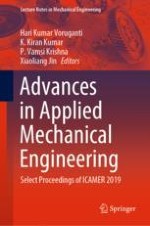This book presents select peer reviewed proceedings of the International Conference on Applied Mechanical Engineering Research (ICAMER 2019). The books examines various areas of mechanical engineering namely design, thermal, materials, manufacturing and industrial engineering covering topics like FEA, optimization, vibrations, condition monitoring, tribology, CFD, IC engines, turbo-machines, automobiles, manufacturing processes, machining, CAM, additive manufacturing, modelling and simulation of manufacturing processing, optimization of manufacturing processing, supply chain management, and operations management. In addition, recent studies on composite materials, materials characterization, fracture and fatigue, advanced materials, energy storage, green building, phase change materials and structural change monitoring are also covered. Given the contents, this book will be useful for students, researchers and professionals working in mechanical engineering and allied fields.
